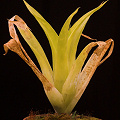Q: Catopsis: The powdery strap airplant
A: Catopsis is a genus of nearly twenty
bromeliad species. Only one, Catopsis berteroniana (Schultes & Schultes) Mez, is of interest to us here. On
first glance, C. berteroniana doesn't look much fancier than the cluster of leaves emerging
from the top of a pineapple. Ah, but first glances can be so deceiving. (As I would always remind my blind dates.)

Catopsis berteroniana
The plant is an epiphyte, which means it lives by clinging to the bare branches of moderate to large trees with sparse foliage,
attached by a dense mass of wiry roots. Indeed, Catopsis berteroniana
is so well adapted to a tree-adhering
lifestyle that plants fallen to the ground die. Healthy plants produce
a rosette of loosely packed leaves. The leaves are so bright yellow that the plant almost appears to glow. The leaves are also
coated with a waxy, powdery white cuticle that enhances the effect.
The image is so evocative of a lamp placed on the bare branches of the tree, that in South American it has earned the
common name lampera de la selva (jungle lantern).
Even I will agree that this is a pretty cool name.
In comparison, the prosaic Latin name, Catopsis, derives from etymology relating to the habit of the plant
as an epiphyte ("hanging"), although the plants don't really hang. Meanwhile, in the last few years the name
"powdery strap airplant" is gaining traction. That's a pretty lame name compared to lampera de la selva, I say!
Hanging or not, the plants attract insects readily, and they are trapped by the slippery leaves. Unlike
Brocchinia reducta, the prey are not caught in the central urn. Instead they mostly slide into a watery
death by the leaves surrounding the center of the plant. Perhaps this is more like the carnivory in
Brocchinia hechtioides?
Are the captured bugs really digested by the plant, or is this done by
commensals? Are the nutrients even absorbed? I am not at all sure, and the evidence is not hugely compelling. I resisted including
Brocchinia and Catopsis in the ranks of carnivorous plants until
relatively recently, and even now I think the evidence for Catopsis is the weaker of the two genera.
But still, I have decided arbitrarily to include it here. Guilty until proven innocent, I suppose. But I am ready to toss this
into the non-carnivorous ghetto of this FAQ at any moment. I might do it tomorrow---who knows?
The details of my rationale for including it among the carnivores are as follows.
- It is an epiphyte that lives on the surface of a tree, gathering detritus as epiphytes so often do. Yet, it prefers trees with little overhanging foliage, and has even has been observed living on telephone wires! It apparently it is not interested in tree-material as a source of detritus.
- It supposedly collects insects at a higher frequency than other bromeliad species.
- It has been found with commensals in its urn, commensals of the same genus (Wyeomyia) as occurs in the clearly carnivorous plant genus Sarracenia.
Catopsis is not eating twigs, but it does gather dead bugs in its maw. What else do
you think it is eating?
I know, this isn't proof, but it is an interesting argument. Today I am convinced by it. Tomorrow I might not be.
Page citations: Frank, J.H. & O'Meara, G.F. 1984;
Juniper, B.E., et al. 1989; Mabberley, D.J. 1987;
McPherson, S. 2006; Rice, B.A. 2006a; Schnell, D.E. 2002a; personal observations.